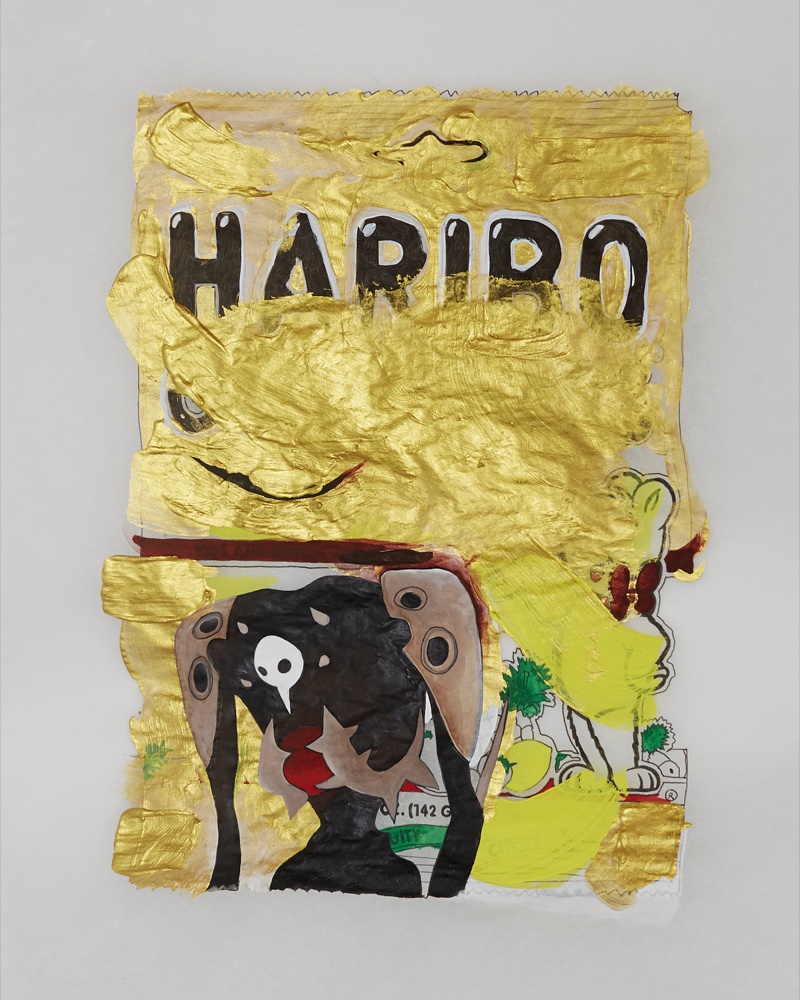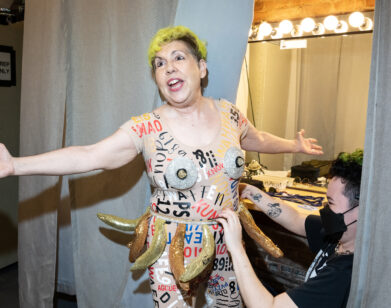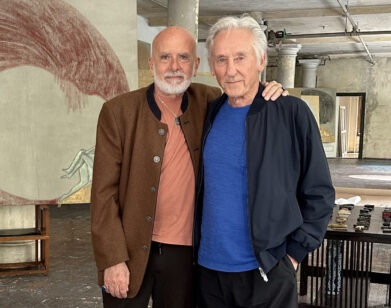Carly Mark, Illuminated
CARLY MARK IN NEW YORK, FEBRUARY 2016. PHOTOS: THOMAS WHITESIDE. STYLING: KATIE BURNETT. MAKEUP: JUNKO KIOKA/JOE MANAGEMENT USING GIORGIO ARMANI BEAUTY, INCLUDING MAESTRO GLOW. HAIR: JOEY GEORGE/THE WALL GROUP USING ORIBE. STYLING ASSISTANT: LAUREN PIVEN.
Like so many who grew up in the Midwest–or nearly anywhere in America after the Mad Men-era advertising boom–artist Carly Mark remembers moments from her childhood in Detroit sprinkled with images of branded food packaging. Though most adults now are wary of such marketing strategies, it’s impossible to deny how the colorful, bold graphics once seemed harmless, if not delightful, and became entwined with memories of certain people and places.
For Mark, 27, her relationship with her grandmother, for instance, has always been tangentially connected to Weight Watchers branded food labels—her grandmother was one of its earliest members, and went on to become a major shareholder. Mark would snack on Weight Watchers products, as well as mass-produced foods like Haribo gummies, Cheetos, and Doritos. When she moved to New York at 18 to study at the School of Visual Arts, she abated the culture shock by exploring her surroundings as much as possible. Bodegas, filled with familiar food brands, became landmarks as she filled out her mental map of the city.
Mark survived college in New York, and moved into her first studio after graduating. “I was asking myself, ‘What do I want to make?’ I started thinking about, ‘What do you like?’ And the only thing I could think of, at the time, was ‘snacks,'” she recalls. “I don’t know if it was because I had so much anxiety that I was leaning towards comfort objects, like comfort foods. But I started illustrating packages of snacks that I was buying.” She painted a bag of food with the only materials she had: tracing paper and watercolors. “I got so lucky, because, when I paint on it, it’s so thin that it wrinkles like a bag. That was complete happenstance.”
In the meantime, Mark worked at the gallery Gavin Brown’s Enterprise, wanting to learn as much as possible about the art world from all angles. She left to pursue art full-time in 2014. Since then, she has guest edited the Fall/Winter 2015 issue of art magazine Foundations, which featured her grandmother as the cover story. To hype the launch, she also conducted a widely circulated online interview with cult designer Lisa Frank, who attended the same Detroit high school as Mark.
In the last few weeks, she has been in overdrive preparing for the first major showing of her work in New York with Breeder Gallery at The Armory Show. She is still working with food packaging–here, a Haribo Gold-Bear package is the dominant motif. But, in the past four years, Mark’s interests have multiplied and evolved: As such, several bags are obscured, sometimes completely, with gold paint, and are interspersed with objects or symbols that resonate with her, from a Memphis Group-designed lamp, to anime characters, to a portrait of her sister.
Separately, Mark is experimenting with large-scale works she calls “physical Reddits,” a compendium of signs or symbols she chooses by a sort of free association with her personal narrative, but that she emphasizes should work as subjective “triggers” of memories.
After Armory, Mark will begin preparing for a residency in Athens that will culminate with her first-ever solo show at Breeder Gallery.
We met with Mark at her Brooklyn studio.
RACHEL SMALL: So, you’ve been playing with depictions of food packaging for a while now.
CARLY MARK: For about four years. When I started to think about it, commercial food makes so much sense for me because of my background. My grandmother, while I was growing up, was the largest shareholder of Weight Watchers International. She started going to classes when it opened up in New York. So, I grew up around packaged, commercially produced food associated with weight loss branding. I grew up with this power female in my life, directly related to commercial food.
Once I figured out how to [paint] packaging efficiently, I started to go further, because aside from sitting and making this object I read, and I see movies, and I am a human that interacts with the world. And I [started asking myself], “What is the intersection point of all these things I’m interested in and the packages?” This new series is definitely the most developed of the bags that I’ve ever done. Different ideas are slicing into the bags.
SMALL: That’s wonderful. Coming to New York and working at Gavin Brown did you think you might stay in galleries for a while or did you always know you were going to come back to art? How did you make your way?
MARK: I always knew being an artist was the goal, that’s why I moved to New York. After SVA I wanted to understand the full spectrum of the art world and working in galleries completed that circle.
SMALL: I feel like galleries can be very mysterious–it’s hard to get a sense of what actually goes on, why decisions are made the way they are. They can be very opaque.
MARK: Michigan in general is very Midwestern; adjusting to New York was not easy at all. But because I moved here when I was 18, and there were so many people older than me that I looked up to in the art world, I understood the importance of paying your dues. It didn’t make sense to me to pursue being an art star at 22-years-old, like a lot of my contemporaries were and are. I wanted to take my time.
SMALL: It’s so much smarter to realize as soon as possible what you don’t know, and be open to learning and picking up new things, because if you come in being confident and charismatic and hearing everyone say yes to you, eventually, people are going to start asking them for too many things, and they might control of things.
MARK: This is a long game. This is a life choice. In my few months at Gavin Brown, the gallery picked up [Elaine] Sturtevant, when she was in her 80s. I want to understand all of this cause it’s a wide spectrum. There’s so much information. If anything, an artist’s job is to somehow organize the infinite amount of information in our changing world, resulting from technology. It’s expanding, quickly. In a lot of my work, I work with food packaging. In some other works, the patterns are inspired by William Morris wallpaper. William Morris was making work that was more reactionary to turn-of-the-century industrialization….
SMALL: That was part of the Arts and Crafts movement, right?
MARK: Yes, it was. His compositions were congested, compacted…because the architecture of the world was changing faster than it ever had before and the wallpapers represented that. The imagery was of the natural world.
SMALL: It’s funny, because learning art history, I thought Duchamp, for instance, and his embrace of mass-produced objects, was so much cooler. Now I think artists like William Morris are so much cooler, because, just with my personal values, I relate to it so much more. I feel like there have been a full century ahead of artists sounding the alarm: we can’t have everything that we come into contact with in our culture be made by huge corporations…
MARK: Yeah, I mean, they were a subtle resistance. It was mostly kept to them, but it was because of their position in society–as important artists and thinkers–that wealthy people collected the work. By placing handcrafted wallpaper in the home of the leaders of the community, he hoped that would influence them to then hold back on industrialization.
SMALL: So, tell me about when you first moved here.
MARK: I used to go to school, take the train, stop at the bodegas, which are now a dying breed, which is so sad for me. I didn’t understand where I was at all. I would go from bodega to bodega; even the underground bodegas in the subway seemed amazing. They all had the Haribo bags.
I’ve always been super interested in mapping. Growing up, I loved Julie Mehretu’s work. I was putting pins all over New York, at least, conceptually, so I didn’t feel like I was floating. Now the city’s so much more gentrified, but I’m still holding on to my bodegas. It also ties into the idea of nostalgia and feeling nostalgic about things and I feel that the bags themselves can play into that idea.
SMALL: It was interesting that you said the Haribo snacks grounded you, because Andy Warhol, who was from Pittsburg, said that he loved Coca-Cola because no matter where you were, it was still a Coke.
MARK: And the soup cans. What could be more comforting?
SMALL: From listening to you talk about your work, and seeing it, it’s clearly an heir to Pop art. What are your thoughts on reconciling what we know about how harmful brands can be, versus Pop art’s celebration of them?
MARK: Well in terms of Pop art and Andy Warhol he, no pun intended, opened up a can of worms.
SMALL: [laughs]
MARK: I don’t think there’s really any going back after Pop art. I grew up on Pop art so I’m keen to it. That actually ties into the idea of commercialized foods. But in the way that Andy Warhol celebrated Coca-Cola and Campbell soup, it’s now, many years later, that we see the repercussions of these commercialized food and it’s making people sick. It’s scary. It makes me think that the artists from the Arts and Crafts movements were right. With the turn of the century with industrialization, The World’s Fair in London [in 1851], where they built The Crystal Palace…They saw that and they saw doom.
SMALL: Even in the following few decades, they had World War I, which was so catastrophic because weapons were mass-produced and more powerful than ever before.
MARK: In The Holy Mountain by Alejandro Jodorowsky, there is a planet led by a woman who mass produces weapons, and another planet run by a man who mass produces art, an art factory. With industrialization, with commercialization, with the manufacturing of all these goods, and, after Pop art, art is the same way now.
It used to be about the work being commercialized and now it’s gotten to this point with social media that the artist is commercialized, and there are many, amazing artists around me who are making art about self-branding. You almost have to at this point; it’s do or die.
SMALL: I feel like people, I guess, older people look at quote-on-quote millennials as being narcissistic, but [using social media] can be a way to make money, or get certain jobs.
MARK: It’s survival.
SMALL: It’s survival. And that’s what so many people don’t get about it.
MARK: It’s crazy. That’s where we’re headed. I mean, that’s where we’ve already gone.
SMALL: On the other hand, I think in a way it is democratic because it is this process of people who vote, literally voting with “likes.”
MARK: It’s this whole evolution; it’s a new thing. We’re evolving into these brand-people. But I think people are forgetting that we’re becoming this completely tech-reliant culture and we’re not even speaking to each other anymore. We’re just texting. It got to a point this past week where I was so exhausted from prepping for Armory that I was texting people in only emojis…which I’m fascinated by, as well. We’re going back to hieroglyphs as a universal language.
SMALL: Socrates was very suspicious of the written word. He did not think it was a good idea because he thought that it would take the human element out of the transmission of ideas. And he was totally right…Karl Marx is an obvious example because of how people interpreted his texts…
MARK: Yeah, it’s like my name.
SMALL: Carly Mark, Karl Marx…that’s crazy! But yeah, people took his ideas and some of the worst men of the 20th century used them to justify their actions. There’s this quote by Marx I came across recently: “I have sown dragons; I reap fleas.” Which is so crazy to think about. With his ideas out in the world in the form of mass produced text, people were able to take that and use it to justify doing horrible things.
MARK: They projected onto it what they wanted to be. Humans are really, really good at projecting. It’s so interesting to think of the written word as being threatening.
SMALL: If something is in writing, you can only take it in so many ways. In discussions, you have a person to ask questions. Images can resonate with the entire world…
MARK: We might all see something a little differently. We don’t know; we’re all not in others’ bodies. Did you know that Aboriginal Australians don’t have a written language? They only pass information orally on to each other. That’s part of the reason why they were almost wiped out and dominated. They couldn’t unify the same way that cultures with a written language could. They even think of time differently. Their time is not linear. It’s stacked. Ancestors, everyone, exists at the same time.
SMALL: That’s so fascinating.
MARK: I mean, I think of mapping in the same way. I’ve been developing these larger pieces, “physical Reddits.” It’s like a self-curated group of images, self-created group of hieroglyphs. At the top, “Goya” refers to the food brand, but also my background in art history, with my mom working at the Detroit Institute of Art. The communist symbols are because of my name, and, on top of that, my grandmother is infamous for wearing red suits. It’s this idea of mapping personal semiotics. [pointing to character] This is from Hayao Miyazaki’s Spirited Away.
SMALL: That movie is so insane.
MARK: I love anime. So, you’ll see bits of anime, commercial foods, art history…
SMALL: I feel like it’s interesting how this relates to a map almost. Conceptually, all things on a map exist at the same time and represent places where things are happening simultaneously, while two people at different points represented by the map will never know what’s happening elsewhere.
MARK: With science comes disbelief in things that are mystical and myth, but the truth is that we exist on these maps, where there are so many things that are going on at once. We try and define everything and we can’t, you know?
THE ARMORY SHOW IS ON VIEW THROUGH THIS SUNDAY, MARCH 6. FOR MORE ON CARLY MARK, VISIT HER WEBSITE.







